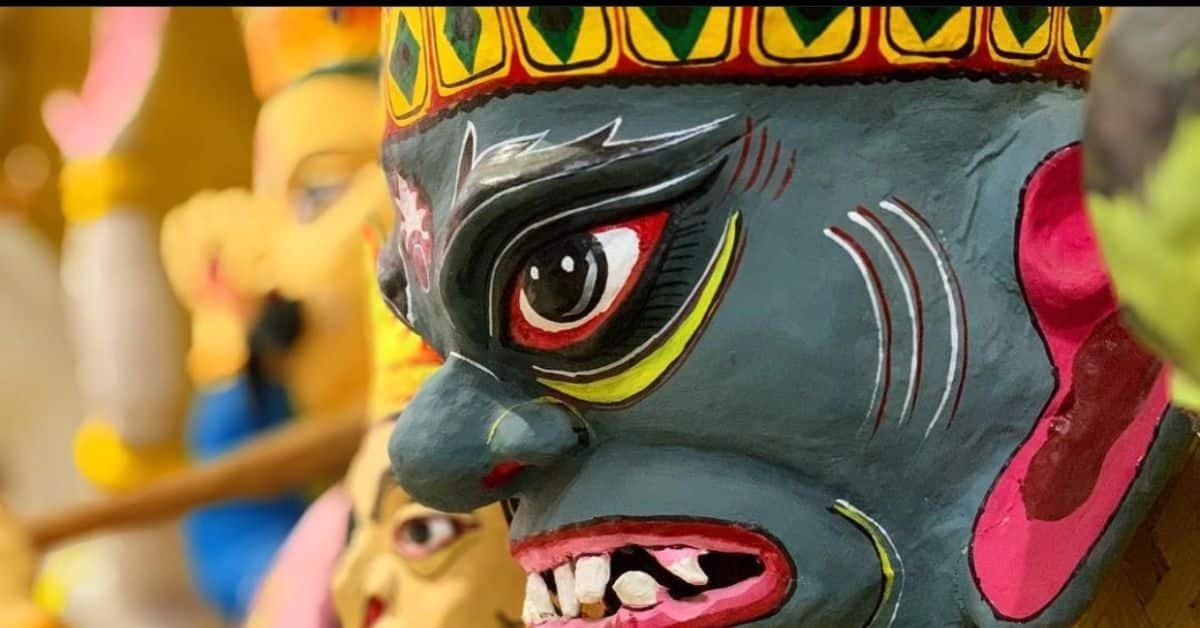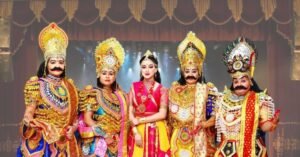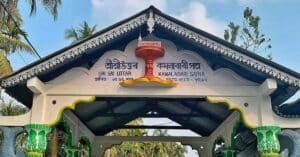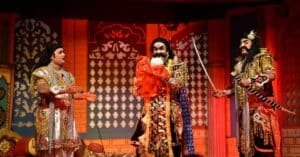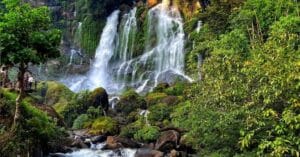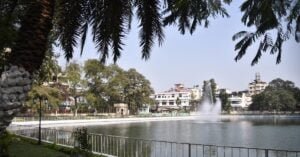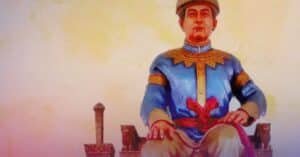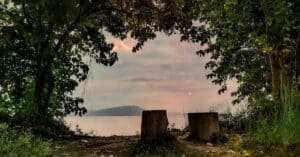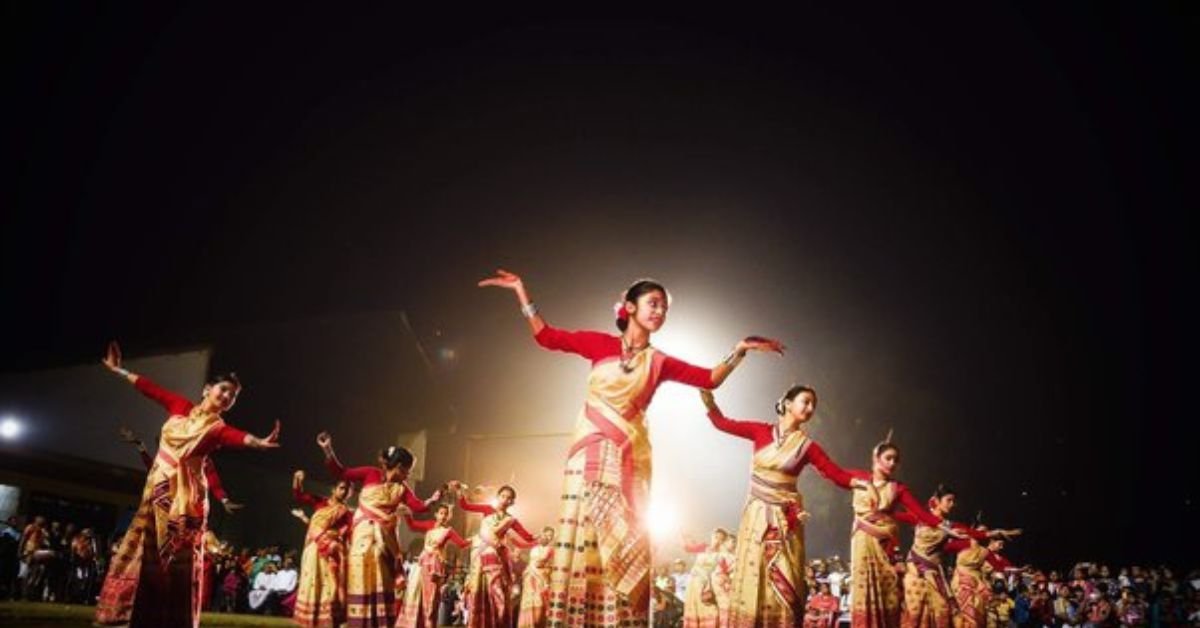Each year, Majuli Island in Assam attracts thousands of tourists who come to experience the Raas Mahotsav, a festival held in November. The Raas festival features traditional plays known as ‘Ankiya Nat Bhaona‘ which means ‘plays’ in Assamese. These bhaonas incorporate the use of colorful masks to portray a wide array of characters. In these blog, we will discuss Mukha Silpa/Shilpa or the art of mask making (মুখা শিল্প in Assamese) in Majuli district of Assam.
About Majuli Island of Assam
Majuli Island of Assam, is renowned as one of the world’s largest river islands, spanning across an extensive area of 483 square kilometers. As a riverine island, Majuli is situated within the waters of the Brahmaputra River. It is one of Assam’s most important cultural centers because of the presence of neo-vaishnavite monasteries called Satra. Satras of Majuli have preserved the century old tradition of Assamese culture. You can visit Majuli island from Jorhat and Lakhimpur district of Assam.
About Raas Mahotsav (Festival) of Majuli
Raas Mahotsav (festival), held in Majuli during November, is a vibrant celebration of the life events of Sri Krishna, a revered Hindu deity. This festival features colorful performances, including dances, plays, and the traditional art form of Bhaona or Ankiya Bhaona, which vividly portrays the life events of Krishna and various other mythological stories.
Read this blog for more about Raas Mahotsav of Majuli
Mukha Shilpa or Mask making in Majuli
Mask making or Mukha Shilpa of Majuli is an age old artform in the island which dates back to the 16th century. Mask making in Majuli is associated with the institution called Satra, a neo-vaishnavite monastery. To spread Neo-Vaishnavism, Sankardeva, the pioneer of Neo-Vaishnavism in Assam, satras were introduced. Later, these Satras became the centers for religious practices. These satras patronized art, craft, painting, literature, music and dance. Besides these, other art forms like mask making, wall and panel painting, manuscript painting and wood carving were developed simultaneously.
Why Masks Were Used in Satras?
In his efforts to promote Neo-Vaishnavism in Assam, Sankardeva utilized narratives from Hindu religious texts to establish a connection with the masses. These religious stories were presented in the form of dramatic performances known as “bhaona” in the Vaishnavite culture of Assam. The themes of these Bhaona performances were drawn from the tales of heroic figures of Krishna and Rama, the Bhāgavata Purāna, and the epic of the Ramayana, all of which were composed by Sankardeva in the 16th century. These narratives were intentionally kept simple to ensure easy comprehension by the common people.
To enhance the liveliness of these dramas, elaborate masks were employed. Performers utilized masks to portray a wide range of characters, including heroes, villains, animals, and divine beings. The variety of masked characters encompassed divine representations, demons, kings, and sub-human entities. In addition to these masks, various animal characters such as elephants, horses, deer, bears, and goats were also vividly represented through the use of masks.
The Art of Mask Making in Majuli
Mask makers have exhibited remarkable ingenuity in their selection and combination of materials for crafting masks. Commonly used materials include bamboo, cane, clay, cloth, paper, metal, pith plant (Aeschynomena Indica), stone, shell, and wood, among others. Craftsmen often work with a local variety of bamboo known as “jatibah,” which falls between the stages of immaturity and full maturity. Sometimes, ‘bijuli bah’ a type of bamboo which has a very thin stem is also used.
Creating the foundation: To start, a piece of bamboo is cut and soaked in pond water or a pool for a period of 5 to 7 days. This soaked bamboo is then cut into smaller sections and woven in an open hexagonal pattern to form the base of the mask.
Layering the mask: The woven base of the mask is overlaid with one or more pieces of old cotton fabric, which are coated with a special type of clay known as “kumarmati” mixed with water before being applied to the masks.

Enhancement and artistic detailing: In earlier times, craftsmen utilized natural colors for enhancing the masks, extracted from various organic sources. Colors like “Hangul” (red) and “Haital” (yellow) were obtained from natural materials. Black was prepared from the ashes of working pots or the soot from kerosene lamps, green was derived from crushed leaves, and white was extracted from a specific type of soil known as “dhal mati,” typically found around 1.5 meters beneath the earth’s surface. For the creation of hair and mustaches, water hyacinth, locally referred to as “pani meteka,” or jute fiber, known as “morapat,” were commonly used.

Types of Masks used in Bhaona
There are three types of masks at Majuli. This are- Mukh Mukha, Cho Mukha or Bor Mukha and Lotokai Mukha.

- Mukh Mukha is worn over the face. It is the smallest verity of the mask here and is widely used in performance.
- Cho mukha or Bor Mukha is very big in size and covers almost the whole upper body of a person. These masks are not flexible. No moveable parts are there in these masks. Often this mask is made two to five feet in height. Due to its huge structure, Cho-Mukha is generally tied to the body of the wearer with ropes
- Lotokai Mukha is akin to Cho Mukha except its small size. Due to its small size, the wearer can easily control it. covers the full body with flexible body parts representing hands, beaks, eyes, jaws, wings, etc. This mask is not tied to the body of the wearer.
Important Places of Mask Making in Majuli
During the time of Sankaradeva, 65 Satras were established, but at present, there are only twenty-two Satras. Among these only four have the magnificent custom of mask making. Mukha Silpa has been practiced and taught in these satras. These are Alengi Narasinha Satra, Bihimpur Satra, Chamaguri Satra or Shamaguri Satra and Natun Chamaguri Satra. All four satras are within the Majuli island of Assam.
Durability and Preservation of Masks
The masks are usually made for theatrical performance which is ritualistic in nature and are used for a few continuous years until they are destroyed by weather or insects. There is a continuous process of making new masks and replacing the damaged one. Traditionally no attempt has been taken to preserve the masks. As a result, considerably older masks cannot be found in these Satras. Nowadays, a little consciousness has been developed to preserve the mask at their preparing stage. The artisan adds a small quantity of kerosene and neem to the paste of ‘kumarmati’ – the potter-clay used in mask making in Majuli. It acts as pesticides and gives the mask durability.
Important People Associated with Mukha Silpa
Kushabanta Dev Goswami of Majuli Chamagori Satra has brought glory to Majuli getting Sangeet-Natak Academy award by establishing the art of Mask Making in the national level. One expert artist of Satra Hemchandra Goswami has given a new dimension to this art though movement of face, eye etc. giving importance to modern technique.
How to experience this unique Artform?
To truly immerse yourself in the captivating world of mask making in Majuli, a visit to Majuli Island during the Raas Festival is a must. Here, you can revel in the enchanting Bhaona performances, where intricate masks bring mythological characters to life. Additionally, during this festive season, seminars dedicated to the art of mask making are organized, offering a unique opportunity to understand the craft firsthand and even create your very own mask.
If you wish to bring a piece of this cultural treasure back with you, the Majuli Music Festival, which follows the Raas Mahotsav, presents the perfect chance to purchase these beautifully crafted masks for your home decoration.
Update: GI Tag for Majuli Mukha Silpa
The Govt. of India granted a Geographical Indication (GI) tag to the traditional Majuli masks in Assam on March 4, 2024. Additionally, the manuscript painting of Majuli also received a GI tag. This designation is bestowed upon products originating from a particular geographical area, denoting distinct characteristics and qualities. Essentially, it functions as a trademark in the global market.

